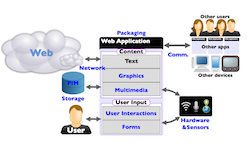The CSS Working Group and the SVG Working Group invite implementations of the Candidate Recommendation of Geometry Interfaces Module Level 1.
This specification provides basic geometric interfaces to represent
points, rectangles, quadrilaterals and transformation matrices that can
be used by other modules or specifications. Learn more about the Style Activity and the Graphics Activity.
Search Engine Marketing| seo tips | w3c Release | Unlock the secrets of SEO success and W3C standards mastery on our blog. Elevate your online presence with expert insights, staying visible and accessible
Friday, November 28, 2014
Filter Effects Module Level 1 Draft Published
25 November 2014
The CSS Working Group and the SVG Working Group have published a Working Draft of Filter Effects Module Level 1.
Filter effects are a way of processing an element’s rendering before it
is displayed in the document. Typically, rendering an element via CSS
or SVG can conceptually be described as if the element, including its
children, are drawn into a buffer (such as a raster image) and then that
buffer is composited into the elements parent. Filters apply an effect
before the compositing stage. Examples of such effects are blurring,
changing color intensity and warping the image. Although originally
designed for use in SVG, filter effects are a set of operations to apply
on an image buffer and therefore can be applied to nearly any
presentational environment, including CSS. They are triggered by a style
instruction (the filter property). This specification describes filters
in a manner that allows them to be used in content styled by CSS, such
as HTML and SVG. It also defines a CSS property value function that
produces a CSS value. Learn more about the Style Activity and the Graphics Activity.
Standards for Web Applications on Mobile: current state and roadmap
20 November 2014
 W3C has published the October 2014 edition of Standards for Web Applications on Mobile,
an overview of the various technologies developed in W3C that increase
the capabilities of Web applications, and how they apply more
specifically to the mobile context.
W3C has published the October 2014 edition of Standards for Web Applications on Mobile,
an overview of the various technologies developed in W3C that increase
the capabilities of Web applications, and how they apply more
specifically to the mobile context.A deliverable of the HTML5Apps project, this edition includes changes and additions since July 2014, notably emerging work such as the Second Screen Presentation Working Group API to request display of content on an external screen, a draft API from the Web Bluetooth Community Group, Device APIs Working Group work on a generic pattern for sensors APIs, as well as work on an API to manage permissions across other APIs. Learn more about the Web and Mobile Interest Group.
Subscribe to:
Posts (Atom)